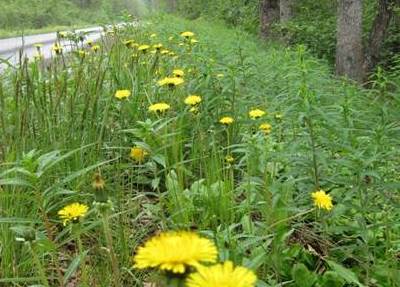
NPS photo
We live with yellow flowers blooming in our backyard every summer. Dandelions are just a part of life as we know it. Children play games with them and stain their clothes with the yellow blossom. Something we don't often realize is that these plants are invasive non-native flowers. But if they haven't been here forever, where did they come from?
First some background:
The common dandelion has the Latin name Taraxacum officinale and belongs to the genus of Taraxacum in the Aster family or Asteraceae. The name "dandelion" comes from the French words "Dent de Lion" meaning the tooth of the lion. The impressive distribution of dandelions is partly due to its remarkable abilities to spread and grow as a plant. Its seeds can travel by air for a very far distance, and a plant can re-grow from as little as a ¼ inch of its root. The dandelion is not only exceptional in its far reaching dispersal but also its ability to thrive in a wide range of habitats, from tropical to arctic, and its adaptability to a wide variety of soils and temperatures.
After doing some research I have come across some interesting history:
Botanists' understanding of dandelions shows that they probably originated in the area of Eurasia. The first record of dandelions comes from Arab texts of the 10th or 11th century. The texts explain how physicians valued the plants for their medicinal properties. At the same time the plant was probably cultivated in India. The Anglo Saxon tribes of Britain and the Normans of France also have records of dandelions growing in Europe. In the 13th century there are accounts of the Welsh utilizing the plant. Fossils of the dandelion have been found as far back as glacial and interglacial times in Europe, suggesting that it has grown there for quite a long time.
The dandelion plants were intentionally spread to America, and records show that they were well established by 1672. The first flowers were brought to the "New World" by the Puritan settlers on the Mayflower to plant for their medicinal and sustenance value. After that, it is likely that the dandelions were spread to the Americas by settlers and explorers, including their introduction to the west coast and Mexico by the Spaniards.
Now, the dandelion's distribution is almost ubiquitous. They grow in all 50 states of the US and almost all of Canada. The plant is found from the Arctic all the way to the sub-Antarctic and on all continents except Antarctica.
Although the wide-spread distribution of this plant makes it hard to pinpoint its origin, the dandelion is native to Eurasia. In most areas the plant is treated as a common weed. Alaska is the only state in which dandelions are being actively treated as an invasive plant in the National Parks.
NPS photo
As the Exotic Plant Management Team (EPMT) we work on keeping the dandelions from dispersing further into the remote reaches of the Kenai Fjords National Park. Pulling plants and seed control are vital steps in hindering the spread of invasive species into the natural native ecosystem. I am nearing the end of my summer working with EPMT, but I will continue to look for plant intruders, and I hope you will do the same!\
-Hannah Beutler, Resource Management Student-Ranger-Student

